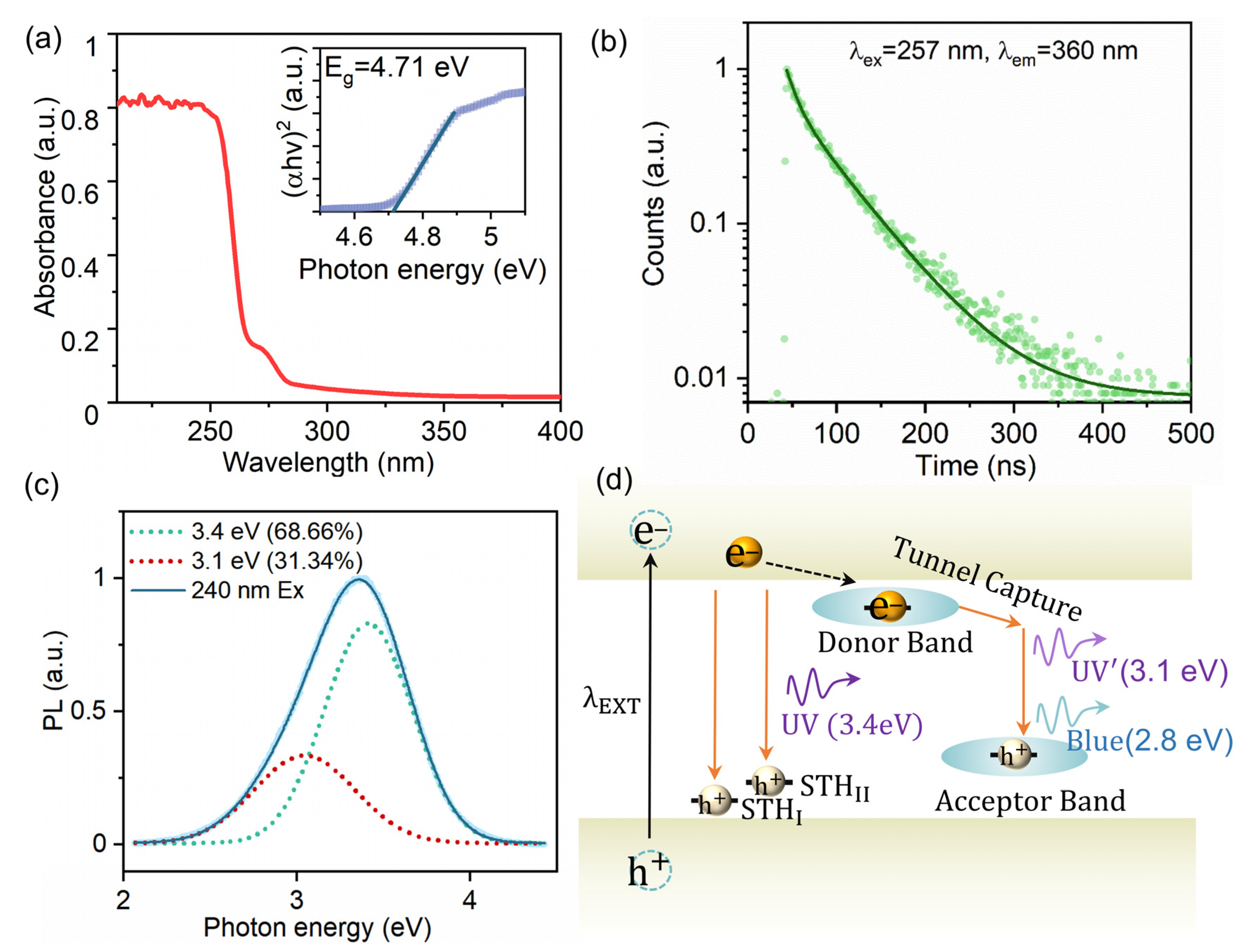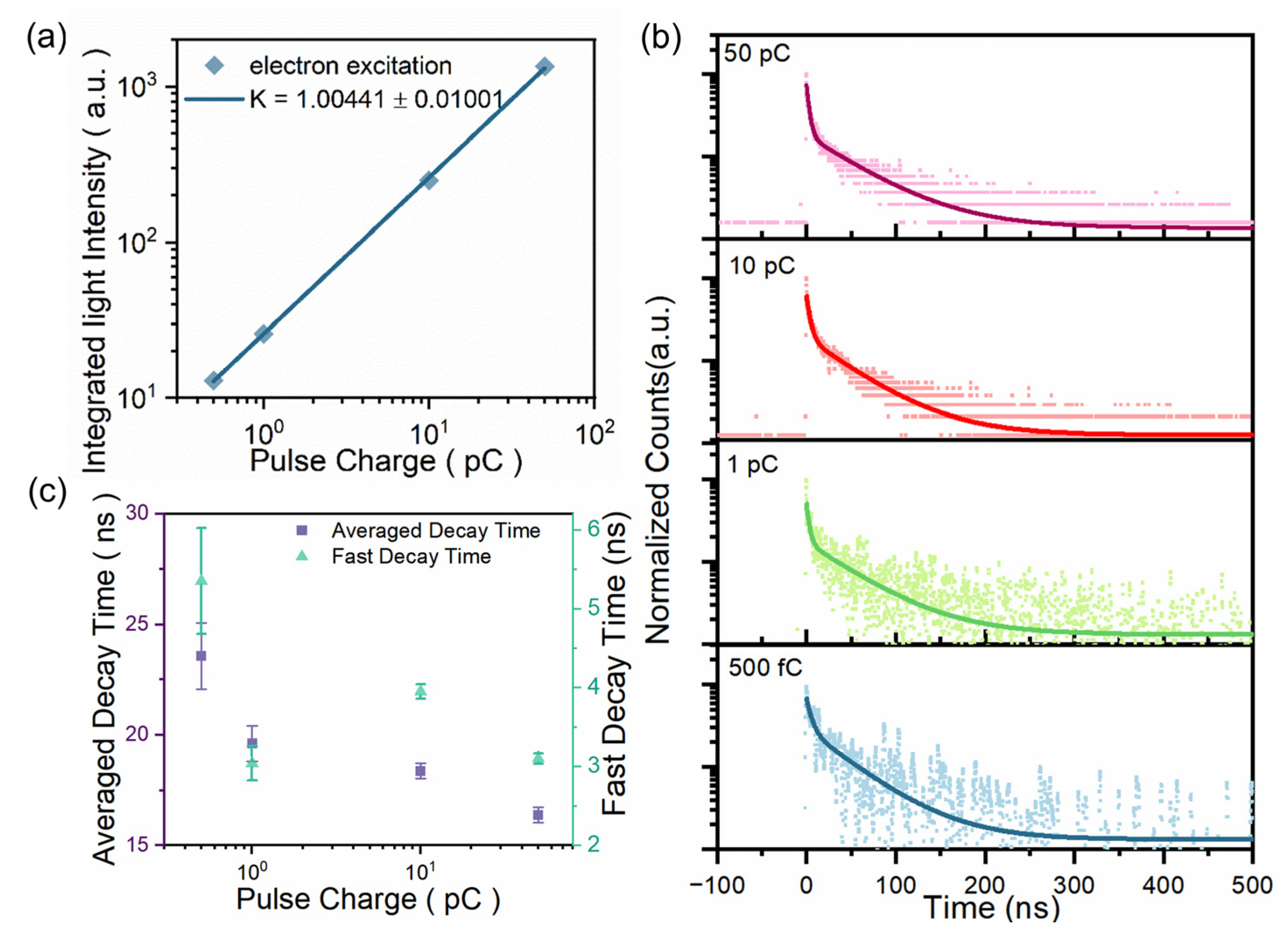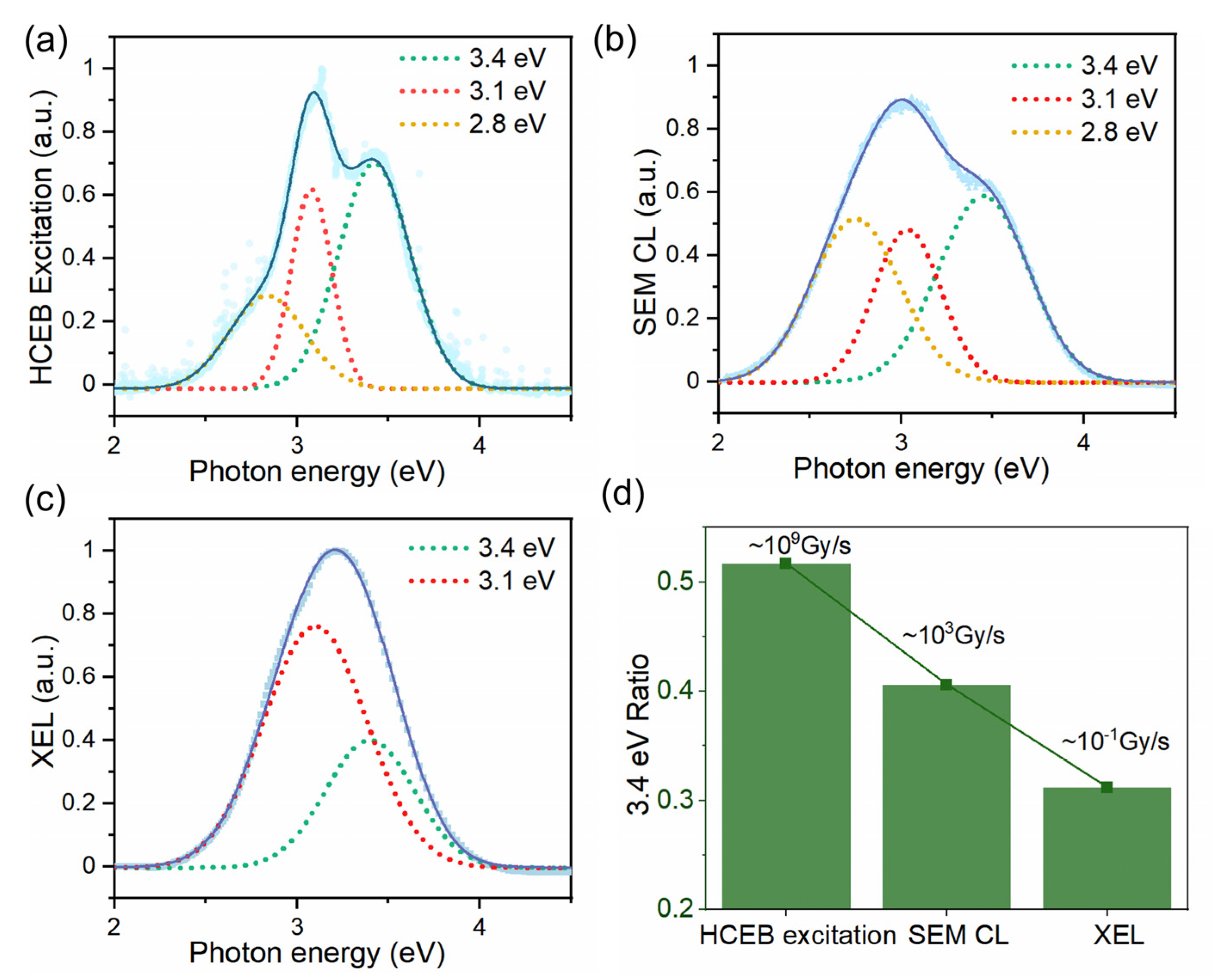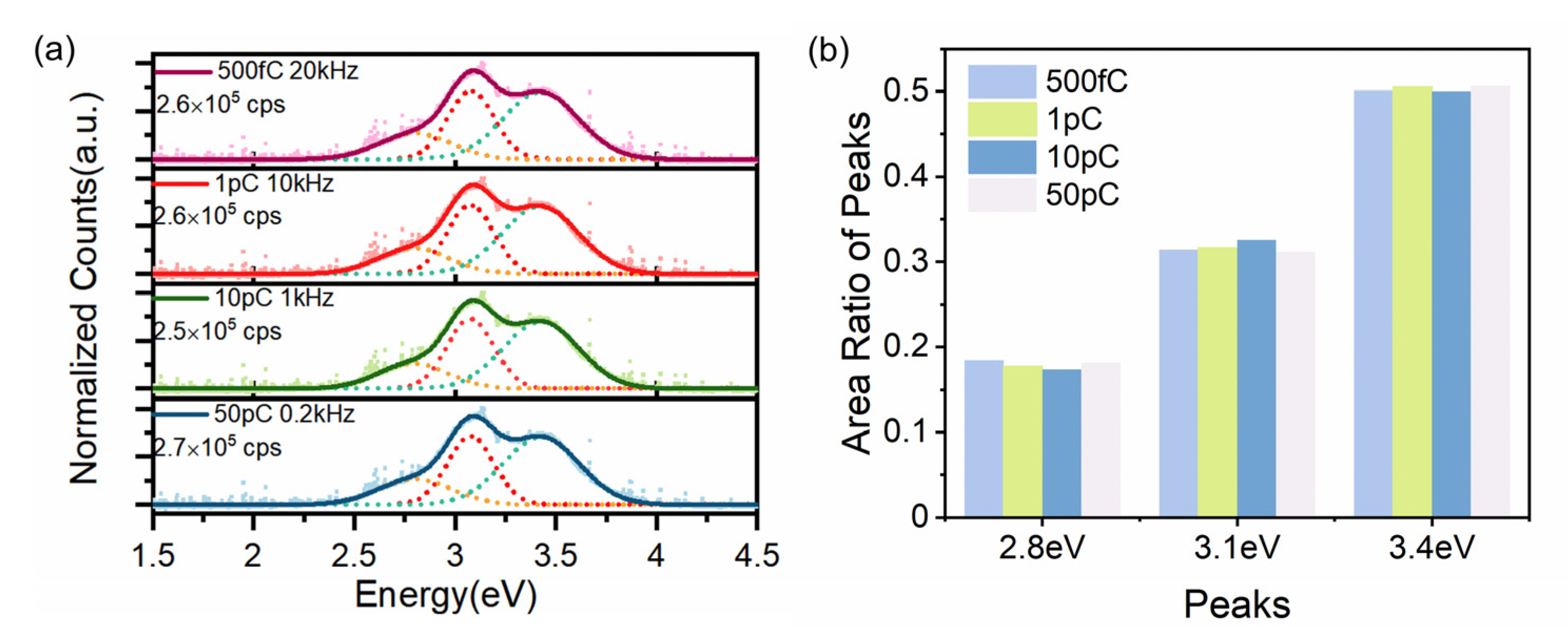Scintillation Properties of β-Ga2O3 Under the Excitation of Ultra-High-Charge Electron Bunches
Abstract
1. Introduction
2. Materials and Experimental Methods
3. Results
3.1. Optical Properties of the Material
3.2. Time Response of Scintillation Excited by High-Charge Electron Bunches
3.3. Scintillation Spectral
4. Discussion
5. Conclusions
Author Contributions
Funding
Institutional Review Board Statement
Informed Consent Statement
Data Availability Statement
Conflicts of Interest
References
- Mangles, S.P.; Murphy, C.D.; Najmudin, Z.; Thomas, A.G.; Collier, J.L.; Dangor, A.E.; Divall, E.J.; Foster, P.S.; Gallacher, J.G.; Hooker, C.J.; et al. Monoenergetic beams of relativistic electrons from intense laser-plasma interactions. Nature 2004, 431, 535–538. [Google Scholar] [CrossRef] [PubMed]
- Geddes, C.G.; Toth, C.S.; Van Tilborg, J.; Esarey, E.; Schroeder, C.B.; Bruhwiler, D.; Nieter, C.; Cary, J.; Leemans, W.P. High-quality electron beams from a laser wakefield accelerator using plasma-channel guiding. Nature 2004, 431, 538–541. [Google Scholar] [CrossRef] [PubMed]
- Feist, A.; Bach, N.; Rubiano da Silva, N.; Danz, T.; Moller, M.; Priebe, K.E.; Domrose, T.; Gatzmann, J.G.; Rost, S.; Schauss, J.; et al. Ultrafast transmission electron microscopy using a laser-driven field emitter: Femtosecond resolution with a high coherence electron beam. Ultramicroscopy 2017, 176, 63–73. [Google Scholar] [CrossRef] [PubMed]
- Vozenin, M.C.; Bourhis, J.; Durante, M. Towards clinical translation of FLASH radiotherapy. Nat. Rev. Clin. Oncol. 2022, 19, 791–803. [Google Scholar] [CrossRef]
- McManus, M.; Romano, F.; Lee, N.D.; Farabolini, W.; Gilardi, A.; Royle, G.; Palmans, H.; Subiel, A. The challenge of ionisation chamber dosimetry in ultra-short pulsed high dose-rate Very High Energy Electron beams. Sci. Rep. 2020, 10, 9089. [Google Scholar] [CrossRef]
- Gardés, E.; Balanzat, E.; Ban-d’Etat, B.; Cassimi, A.; Durantel, F.; Grygiel, C.; Madi, T.; Monnet, I.; Ramillon, J.M.; Ropars, F.; et al. SPORT: A new sub-nanosecond time-resolved instrument to study swift heavy ion-beam induced luminescence—Application to luminescence degradation of a fast plastic scintillator. Nucl. Instrum. Methods Phys. Res. Sect. B Beam Interact. Mater. At. 2013, 297, 39–43. [Google Scholar] [CrossRef]
- He, N.; Tang, H.; Liu, B.; Zhu, Z.; Li, Q.; Guo, C.; Gu, M.; Xu, J.; Liu, J.; Xu, M.; et al. Ultra-fast scintillation properties of β-Ga2O3 single crystals grown by Floating Zone method. Nucl. Instrum. Methods Phys. Res. Sect. A Accel. Spectrometers, Detect. Assoc. Equip. 2018, 888, 9–12. [Google Scholar] [CrossRef]
- Koshimizu, M.; Kimura, A.; Kurashima, S.; Taguchi, M.; Yanagida, T.; Fujimoto, Y.; Asai, K. Effect of linear energy transfer on the scintillation properties of Ce-doped Ca3B2O6 crystals. Nucl. Instrum. Methods Phys. Res. Sect. B-Beam Interact. Mater. At. 2020, 471, 59–62. [Google Scholar] [CrossRef]
- Chen, X.; Han, H.-T.; Li, G. Experimental study on high dose rate response of cadmium zinc telluride detectors to pulsed X-ray. Radiat. Meas. 2017, 97, 42–46. [Google Scholar] [CrossRef]
- Grim, J.Q.; Ucer, K.B.; Burger, A.; Bhattacharya, P.; Tupitsyn, E.; Rowe, E.; Buliga, V.M.; Trefilova, L.; Gektin, A.; Bizarri, G.A.; et al. Nonlinear quenching of densely excited states in wide-gap solids. Phys. Rev. B 2013, 87, 125117. [Google Scholar] [CrossRef]
- Laasner, R.; Fedorov, N.; Grigonis, R.; Guizard, S.; Kirm, M.; Makhov, V.; Markov, S.; Nagirnyi, V.; Sirutkaitis, V.; Vasil’ev, A.; et al. Band tail absorption saturation in CdWO4 with 100 fs laser pulses. J. Phys. Condens. Matter 2013, 25, 245901. [Google Scholar] [CrossRef] [PubMed]
- Guan, X.; Zhang, Z.; Zhang, W. Measurement of Linear Response Upper Limit for Lutecium Oxyorthosilicate Scitillator in High Dose Rate to Pulsed Gamma Radiation. At. Energy Sci. Technol. 2009, 43, 942–945. [Google Scholar]
- Peng, C.; Zhang, K.; Yang, L.; Zheng, J.Q.; Lu, Y.; Hou, Y.Y.; Yan, X.L.; Shi, Z.J.; Han, H.T.; Song, Z.H.; et al. Investigation on the Fast Component Light Yield of BaF2: Y Crystal. IEEE Trans. Nucl. Sci. 2022, 69, 2083–2088. [Google Scholar] [CrossRef]
- Yanagida, T.; Kamada, K.; Fujimoto, Y.; Yagi, H.; Yanagitani, T. Comparative study of ceramic and single crystal Ce: GAGG scintillator. Opt. Mater. 2013, 35, 2480–2485. [Google Scholar] [CrossRef]
- Xue, Z.; Chen, L.; Zhao, S.; Yang, F.; An, R.; Wang, L.; Sun, Y.-Y.; Feng, H.; Ding, D. Enhancement of scintillation properties of LYSO: Ce crystals by Al codoping. Cryst. Growth Des. 2023, 23, 4562–4570. [Google Scholar] [CrossRef]
- Pustovarov, V.A.; Razumov, A.N.; Vyprintsev, D.I. Luminescence of LaBr3: Ce, Hf crystals under photon excitation in the ultraviolet, vacuum ultraviolet, and X-ray ranges. Phys. Solid State 2014, 56, 347–352. [Google Scholar] [CrossRef]
- Mykhaylyk, V.B.; Kraus, H.; Kapustianyk, V.; Rudko, M. Low temperature scintillation properties of Ga2O3. Appl. Phys. Lett. 2019, 115, 081103. [Google Scholar] [CrossRef]
- Hoshikawa, K.; Ohba, E.; Kobayashi, T.; Yanagisawa, J.; Miyagawa, C.; Nakamura, Y. Growth of β-Ga2O3 single crystals using vertical Bridgman method in ambient air. J. Cryst. Growth 2016, 447, 36–41. [Google Scholar] [CrossRef]
- Petkov, A.; Cherns, D.; Chen, W.-Y.; Liu, J.; Blevins, J.; Gambin, V.; Li, M.; Liu, D.; Kuball, M. Structural stability of β-Ga2O3 under ion irradiation. Appl. Phys. Lett. 2022, 121, 171903. [Google Scholar] [CrossRef]
- Tang, H.; He, N.; Zhu, Z.; Gu, M.; Liu, B.; Xu, J.; Xu, M.; Chen, L.; Liu, J.; Ouyang, X. Temperature-dependence of X-ray excited luminescence of β-Ga2O3 single crystals. Appl. Phys. Lett. 2019, 115, 071904. [Google Scholar] [CrossRef]
- Li, Z.; Tang, H.; Li, Y.; Gu, M.; Xu, J.; Chen, L.; Liu, J.; Ouyang, X.; Liu, B. Enhanced scintillation performance of β-Ga2O3 single crystals by Al3+ doping and its physical mechanism. Appl. Phys. Lett. 2022, 121, 102102. [Google Scholar] [CrossRef]
- Stepanov, S.I.; Nikolaev, V.I.; Bougrov, V.E.; Romanov, A.E. Gallium Oxide: Properties and Applications—A Review. Rev. Adv. Mater. Sci. 2016, 44, 63–86. [Google Scholar]
- Pozina, G.; Forsberg, M.; Kaliteevski, M.A.; Hemmingsson, C. Emission properties of Ga2O3 nano-flakes: Effect of excitation density. Sci. Rep. 2017, 7, 42132. [Google Scholar] [CrossRef]
- He, N.; Ouyang, X.; Xu, M.; Tang, H.; Liu, B.; Zhu, Z.; Gu, M.; Xu, J.; Liu, J.; Chen, L. Scintillation Properties of β-Ga2O3 Single Crystal Excited by α-Ray. IEEE Trans. Nucl. Sci. 2020, 67, 400–404. [Google Scholar] [CrossRef]
- Valdes, D.J.; Miller, S.; Leak, C.; Haque, S.; Gunthoti, K.; Wender, S.A.; Paneru, S.; Lee, H.Y.; Vogel, S.C.; Sun, K.X. Gallium oxide (Ga2O3) energy dependent scintillation response to fast neutrons and flash gamma-rays. Rev. Sci. Instrum. 2024, 95, 083549. [Google Scholar] [CrossRef]
- Jia, H.; Li, T.; Wang, T.; Zhao, Y.; Zhang, X.; Xu, H.; Liu, Z.; Liu, J.; Lin, L.; Xie, H.; et al. High-brightness megahertz-rate beam from a direct-current and superconducting radio-frequency combined photocathode gun. Phys. Rev. Res. 2024, 6, 043165. [Google Scholar] [CrossRef]
- Sun, J.; Lv, J.; Tian, S.; Liu, J.; Zhang, Z.; Xu, H.; Lin, L.; Huang, S. Dosimetry study of high repetition rate MeV electron beam from a continuous-wave photocathode gun. arXiv 2024, arXiv:2411.16247. [Google Scholar]
- Zhu, W.; Ma, W.; Su, Y.; Chen, Z.; Chen, X.; Ma, Y.; Bai, L.; Xiao, W.; Liu, T.; Zhu, H.; et al. Low-dose real-time X-ray imaging with nontoxic double perovskite scintillators. Light. Sci. Appl. 2020, 9, 112. [Google Scholar] [CrossRef]
- Li, Y.; Shao, W.; Chen, L.; Wang, J.; Nie, J.; Zhang, H.; Zhang, S.; Gao, R.; Ouyang, X.; Ouyang, X.; et al. Lead-halide Cs4PbBr6 single crystals for high-sensitivity radiation detection. NPG Asia Mater. 2021, 13, 40. [Google Scholar] [CrossRef]
- Lin, R.; Zhu, Y.; Chen, L.; Zheng, W.; Xu, M.; Ruan, J.; Li, R.; Li, T.; Lin, Z.; Cheng, L.; et al. Ultrafast (600 ps) α-ray scintillators. PhotoniX 2022, 3, 9. [Google Scholar] [CrossRef]
- Zhang, J.; Dong, P.; Dang, K.; Zhang, Y.; Yan, Q.; Xiang, H.; Su, J.; Liu, Z.; Si, M.; Gao, J.; et al. Ultra-wide bandgap semiconductor Ga2O3 power diodes. Nat. Commun. 2022, 13, 3900. [Google Scholar] [CrossRef] [PubMed]
- Galazka, Z. β- Ga2O3 for wide-bandgap electronics and optoelectronics. Semicond. Sci. Technol. 2018, 33, 113001. [Google Scholar] [CrossRef]
- Usui, Y.; Kato, T.; Kawano, N.; Okada, G.; Kawaguchi, N.; Yanagida, T. Comparative study of scintillation properties of Ga2O3 single crystals and ceramics. J. Lumin. 2018, 200, 81–86. [Google Scholar] [CrossRef]
- Usui, Y.; Oya, T.; Okada, G.; Kawaguchi, N.; Yanagida, T. Comparative study of scintillation and optical properties of Ga2O3 doped with ns2 ions. Mater. Res. Bull. 2017, 90, 266–272. [Google Scholar] [CrossRef]
- Anand, A.; Zaffalon, M.L.; Cova, F.; Pinchetti, V.; Khan, A.H.; Carulli, F.; Brescia, R.; Meinardi, F.; Moreels, I.; Brovelli, S. Optical and Scintillation Properties of Record-Efficiency CdTe Nanoplatelets toward Radiation Detection Applications. Nano Lett. 2022, 22, 8900–8907. [Google Scholar] [CrossRef] [PubMed]
- Huso, J.; McCluskey, M.D.; Yu, Y.; Islam, M.M.; Selim, F. Localized UV emitters on the surface of beta- Ga2O3. Sci. Rep. 2020, 10, 21022. [Google Scholar] [CrossRef] [PubMed]
- Abram, R.A.; Rees, G.J.; Wilson, B.L.H. Heavily doped semiconductors and devices. Adv. Phys. 1978, 27, 799–892. [Google Scholar] [CrossRef]
- Yang, X.; Tang, H.; Zhang, C.; Li, X.; Wang, W.; Huang, X.; Peng, X.; Zhang, C.; Xu, J.; Liu, B. Luminescence properties of β-Ga2O3: Bi single crystals growth by the optical floating zone method. J. Lumin. 2025, 278, 12100238. [Google Scholar] [CrossRef]
- Li, X.; Chen, J.; Yang, D.; Chen, X.; Geng, D.; Jiang, L.; Wu, Y.; Meng, C.; Zeng, H. Mn2+ induced significant improvement and robust stability of radioluminescence in Cs3Cu2I5 for high-performance nuclear battery. Nat. Commun. 2021, 12, 3879. [Google Scholar] [CrossRef]
- Kirm, M.; Nagirnyi, V.; Feldbach, E.; De Grazia, M.; Carré, B.; Merdji, H.; Guizard, S.; Geoffroy, G.; Gaudin, J.; Fedorov, N.; et al. Exciton-exciton interactions in CdWO4 irradiated by intense femtosecond vacuum ultraviolet pulses. Phys. Rev. B 2009, 79, 233103. [Google Scholar] [CrossRef]
- Aleksiejunas, R.; Podlipskas, Z.; Nargelas, S.; Kadys, A.; Kolenda, M.; Nomeika, K.; Mickevicius, J.; Tamulaitis, G. Direct Auger recombination and density-dependent hole diffusion in InN. Sci. Rep. 2018, 8, 4621. [Google Scholar] [CrossRef] [PubMed]
- García Víllora, E.; Hatanaka, K.; Odaka, H.; Sugawara, T.; Miura, T.; Fukumura, H.; Fukuda, T. Luminescence of undoped β- Ga2O3 single crystals excited by picosecond X-ray and sub-picosecond UV pulses. Solid State Commun. 2003, 127, 385–388. [Google Scholar] [CrossRef]





| Bunch Charge (pC) | Dose Rate (Gy/s) | τ1 (ns) | τ2 (ns) | Averaged Decay Time τ (ns) |
|---|---|---|---|---|
| 0.5 | 4 × 107 | 5.35 (60.22%) | 51.14 (39.78%) | 23.57 |
| 1 | 8 × 107 | 3.04 (69.20%) | 56.83 (30.80%) | 19.61 |
| 10 | 8 × 108 | 3.95 (71.16%) | 53.92 (28.84%) | 18.36 |
| 50 | 4 × 109 | 3.10 (76.45%) | 59.49 (23.55%) | 16.38 |
| Excitation Methods | 3.4 eV | DAP | 3.1 eV | 2.8 eV |
|---|---|---|---|---|
| XEL | 31.2% | 68.8% | 68.8% | 0 |
| SEM CL | 40.6% | 59.4% | 24.5% | 34.9% |
| HCEB excitation | 51.7% | 48.3% | 25.7% | 22.6% |
Disclaimer/Publisher’s Note: The statements, opinions and data contained in all publications are solely those of the individual author(s) and contributor(s) and not of MDPI and/or the editor(s). MDPI and/or the editor(s) disclaim responsibility for any injury to people or property resulting from any ideas, methods, instructions or products referred to in the content. |
© 2025 by the authors. Licensee MDPI, Basel, Switzerland. This article is an open access article distributed under the terms and conditions of the Creative Commons Attribution (CC BY) license (https://creativecommons.org/licenses/by/4.0/).
Share and Cite
Liang, Y.; Sun, J.; Zhang, C.; Xu, T.; Chen, H.; Huang, H.; Hua, C.; Wan, P.; Dai, C.; Wu, Q.; et al. Scintillation Properties of β-Ga2O3 Under the Excitation of Ultra-High-Charge Electron Bunches. Photonics 2025, 12, 149. https://doi.org/10.3390/photonics12020149
Liang Y, Sun J, Zhang C, Xu T, Chen H, Huang H, Hua C, Wan P, Dai C, Wu Q, et al. Scintillation Properties of β-Ga2O3 Under the Excitation of Ultra-High-Charge Electron Bunches. Photonics. 2025; 12(2):149. https://doi.org/10.3390/photonics12020149
Chicago/Turabian StyleLiang, Yulan, Jianhan Sun, Chaoyi Zhang, Tianqi Xu, Haoran Chen, Huaqing Huang, Chenhao Hua, Pengying Wan, Chuanwei Dai, Qingfan Wu, and et al. 2025. "Scintillation Properties of β-Ga2O3 Under the Excitation of Ultra-High-Charge Electron Bunches" Photonics 12, no. 2: 149. https://doi.org/10.3390/photonics12020149
APA StyleLiang, Y., Sun, J., Zhang, C., Xu, T., Chen, H., Huang, H., Hua, C., Wan, P., Dai, C., Wu, Q., Liu, J., Huang, L., Lin, L., Tang, H., Xue, J., Xu, J., Huang, S., Liu, B., & Ma, W. (2025). Scintillation Properties of β-Ga2O3 Under the Excitation of Ultra-High-Charge Electron Bunches. Photonics, 12(2), 149. https://doi.org/10.3390/photonics12020149





